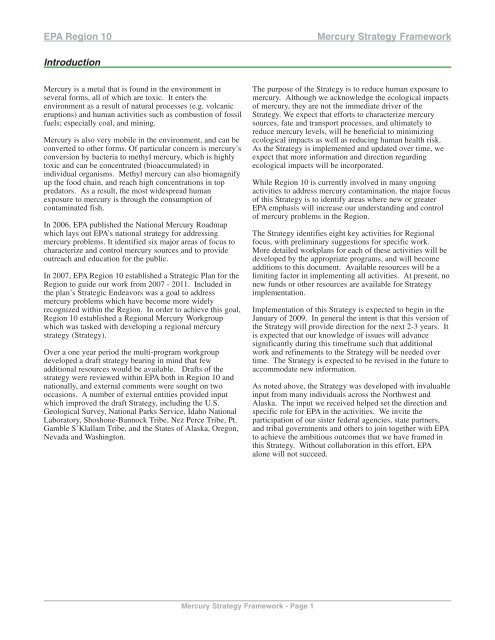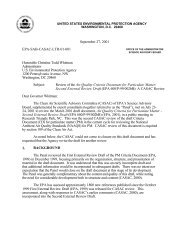EPA Region 10 Mercury Strategy Framework - Environmental ...
EPA Region 10 Mercury Strategy Framework - Environmental ...
EPA Region 10 Mercury Strategy Framework - Environmental ...
- No tags were found...
You also want an ePaper? Increase the reach of your titles
YUMPU automatically turns print PDFs into web optimized ePapers that Google loves.
<strong>EPA</strong> <strong>Region</strong> <strong>10</strong><strong>Mercury</strong> <strong>Strategy</strong> <strong>Framework</strong>Introduction<strong>Mercury</strong> is a metal that is found in the environment inseveral forms, all of which are toxic. It enters theenvironment as a result of natural processes (e.g. volcaniceruptions) and human activities such as combustion of fossilfuels; especially coal, and mining.<strong>Mercury</strong> is also very mobile in the environment, and can beconverted to other forms. Of particular concern is mercury’sconversion by bacteria to methyl mercury, which is highlytoxic and can be concentrated (bioaccumulated) inindividual organisms. Methyl mercury can also biomagnifyup the food chain, and reach high concentrations in toppredators. As a result, the most widespread humanexposure to mercury is through the consumption ofcontaminated fish.In 2006, <strong>EPA</strong> published the National <strong>Mercury</strong> Roadmapwhich lays out <strong>EPA</strong>’s national strategy for addressingmercury problems. It identified six major areas of focus tocharacterize and control mercury sources and to provideoutreach and education for the public.In 2007, <strong>EPA</strong> <strong>Region</strong> <strong>10</strong> established a Strategic Plan for the<strong>Region</strong> to guide our work from 2007 - 2011. Included inthe plan’s Strategic Endeavors was a goal to addressmercury problems which have become more widelyrecognized within the <strong>Region</strong>. In order to achieve this goal,<strong>Region</strong> <strong>10</strong> established a <strong>Region</strong>al <strong>Mercury</strong> Workgroupwhich was tasked with developing a regional mercurystrategy (<strong>Strategy</strong>).Over a one year period the multi-program workgroupdeveloped a draft strategy bearing in mind that fewadditional resources would be available. Drafts of thestrategy were reviewed within <strong>EPA</strong> both in <strong>Region</strong> <strong>10</strong> andnationally, and external comments were sought on twooccasions. A number of external entities provided inputwhich improved the draft <strong>Strategy</strong>, including the U.S.Geological Survey, National Parks Service, Idaho NationalLaboratory, Shoshone-Bannock Tribe, Nez Perce Tribe, Pt.Gamble S’Klallam Tribe, and the States of Alaska, Oregon,Nevada and Washington.The purpose of the <strong>Strategy</strong> is to reduce human exposure tomercury. Although we acknowledge the ecological impactsof mercury, they are not the immediate driver of the<strong>Strategy</strong>. We expect that efforts to characterize mercurysources, fate and transport processes, and ultimately toreduce mercury levels, will be beneficial to minimizingecological impacts as well as reducing human health risk.As the <strong>Strategy</strong> is implemented and updated over time, weexpect that more information and direction regardingecological impacts will be incorporated.While <strong>Region</strong> <strong>10</strong> is currently involved in many ongoingactivities to address mercury contamination, the major focusof this <strong>Strategy</strong> is to identify areas where new or greater<strong>EPA</strong> emphasis will increase our understanding and controlof mercury problems in the <strong>Region</strong>.The <strong>Strategy</strong> identifies eight key activities for <strong>Region</strong>alfocus, with preliminary suggestions for specific work.More detailed workplans for each of these activities will bedeveloped by the appropriate programs, and will becomeadditions to this document. Available resources will be alimiting factor in implementing all activities. At present, nonew funds or other resources are available for <strong>Strategy</strong>implementation.Implementation of this <strong>Strategy</strong> is expected to begin in theJanuary of 2009. In general the intent is that this version ofthe <strong>Strategy</strong> will provide direction for the next 2-3 years. Itis expected that our knowledge of issues will advancesignificantly during this timeframe such that additionalwork and refinements to the <strong>Strategy</strong> will be needed overtime. The <strong>Strategy</strong> is expected to be revised in the future toaccommodate new information.As noted above, the <strong>Strategy</strong> was developed with invaluableinput from many individuals across the Northwest andAlaska. The input we received helped set the direction andspecific role for <strong>EPA</strong> in the activities. We invite theparticipation of our sister federal agencies, state partners,and tribal governments and others to join together with <strong>EPA</strong>to achieve the ambitious outcomes that we have framed inthis <strong>Strategy</strong>. Without collaboration in this effort, <strong>EPA</strong>alone will not succeed.<strong>Mercury</strong> <strong>Strategy</strong> <strong>Framework</strong> - Page 1
















